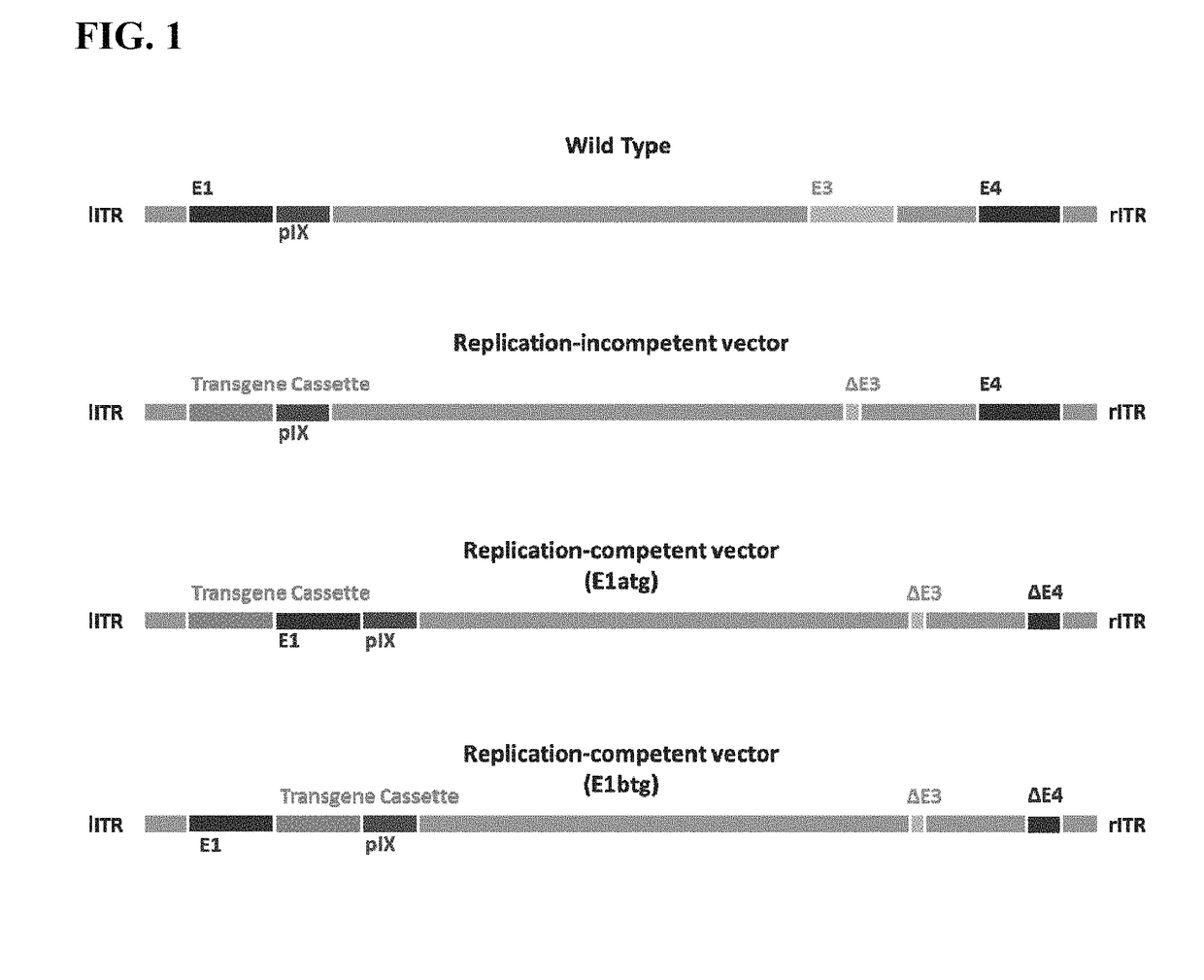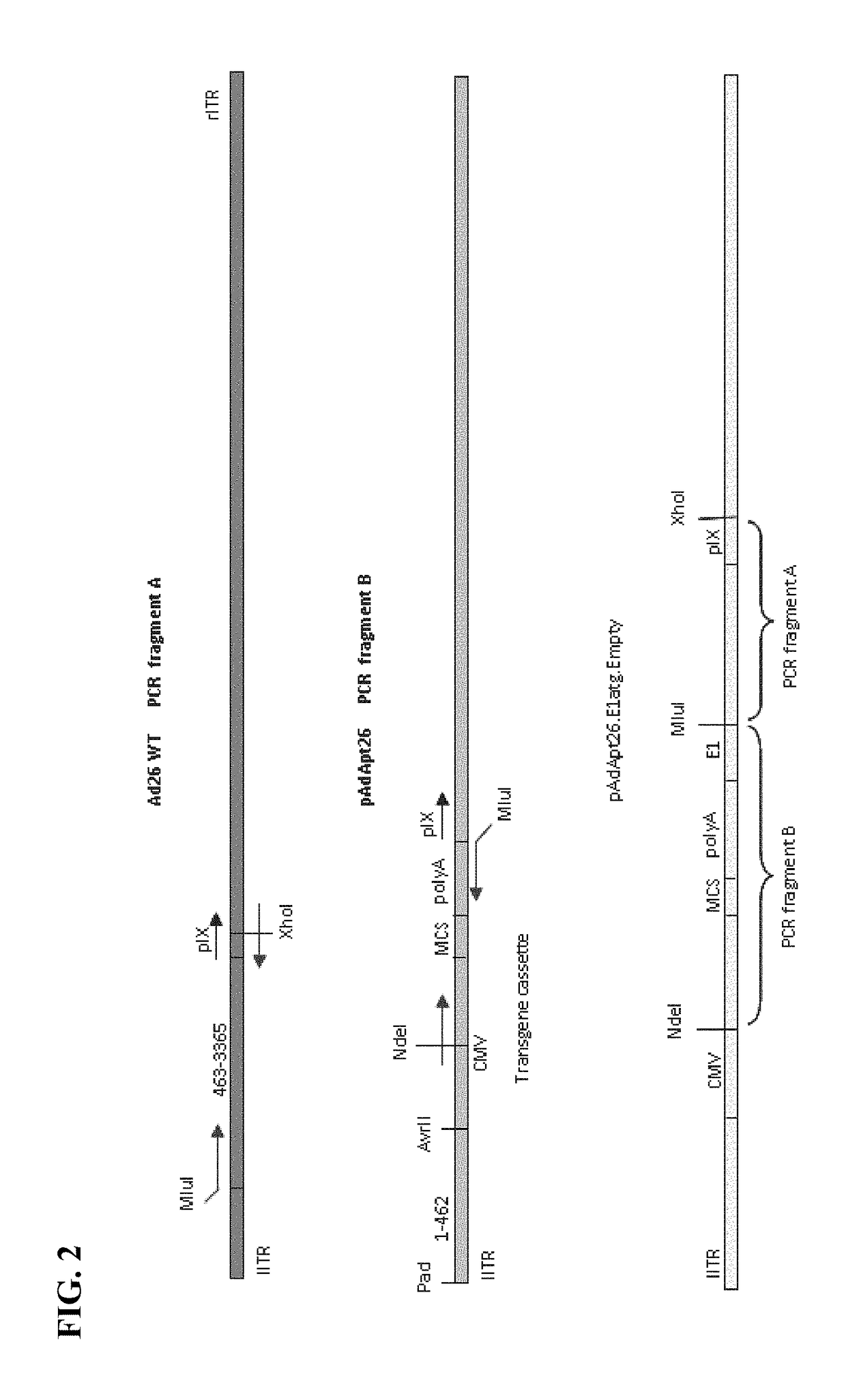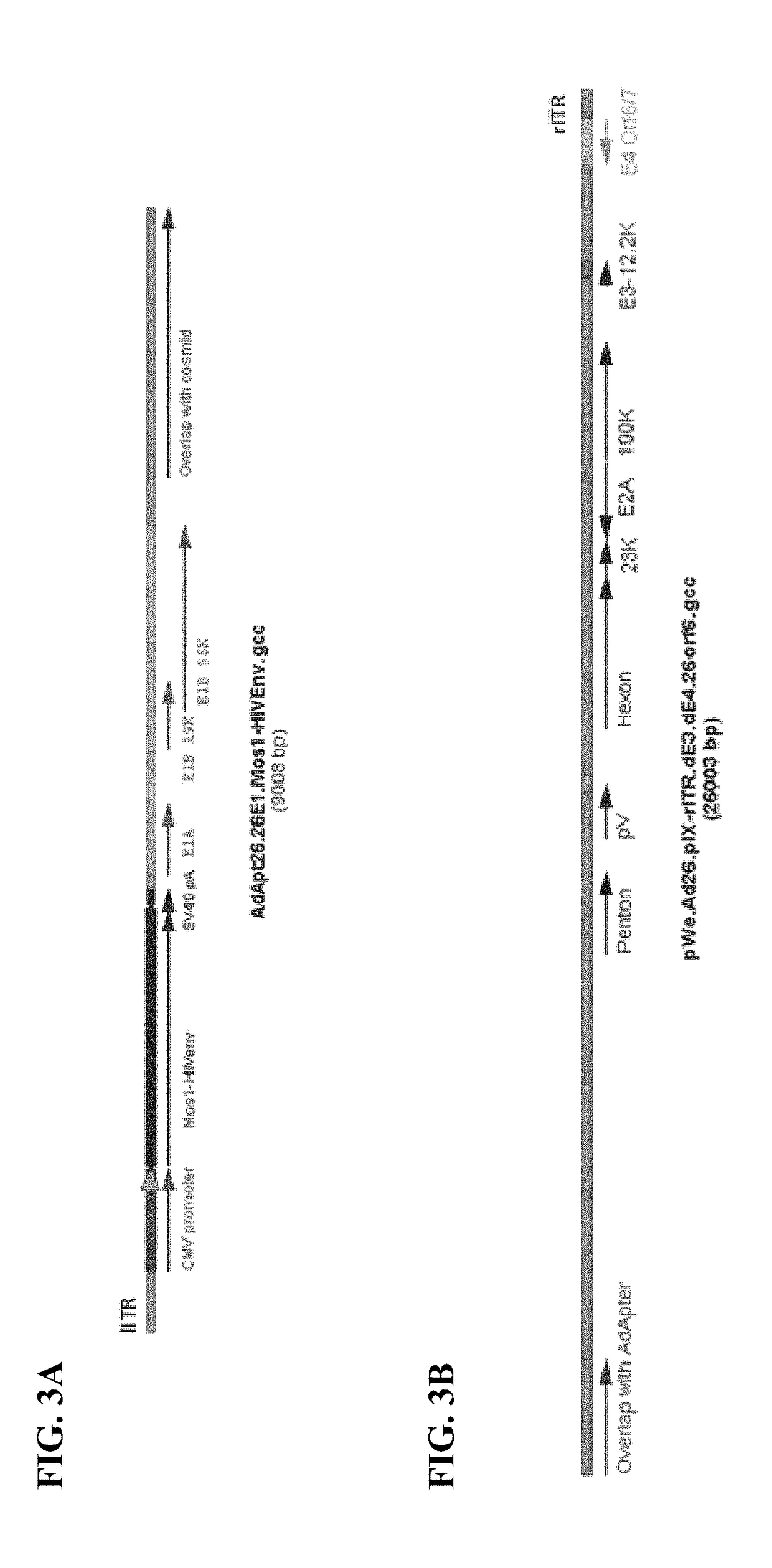Replicating recombinant adenovirus vectors, compositions, and methods of use thereof
a technology of recombinant adenovirus and vector, applied in the direction of dsdna viruses, immunodeficiency virus, antibody medical ingredients, etc., can solve the problem of inapplicability of inability to apply hiv human vaccine strategy, and inability to achieve rapid diagnosis and treatment.
- Summary
- Abstract
- Description
- Claims
- Application Information
AI Technical Summary
Benefits of technology
Problems solved by technology
Method used
Image
Examples
example 1
Cloning of Empty Ad26 Adaptor Plasmid (pAdApt26.E1atg.Empty) with E1 Coding Region after Transgene Cassette
[0183]The empty Ad26 recombinant vector, pAdAp26.E1atg.Empty (SEQ ID NO: 3) was constructed as shown in FIG. 2. The pAdApt26.E1atg.Empty vector contains the E1 coding region after the transgene cassette. “Empty” denotes that the vector does not contain a heterologous nucleic acid sequence or transgene, however any heterologous nucleic acid sequence of interest can be inserted into the multiple cloning site of the transgene cassette of the pAdApt26.E1atg.Empty vector under control of the CMV promoter, and upstream of the E1 coding region.
[0184]Production of “PCR Fragment A” and “PCR Fragment B”
[0185]Two polymerase chain reactions (PCRs) were set up. The first PCR was to amplify the E1 coding region from the wild-type adenovirus vector genome (“Ad26 WT”), and was performed using the following primer pair: forward primer, Ad26WT.463.MluI.fwd 5′-CACAGACGCGTATCAGCTGATCCGCAGGGTATTTA-...
example 2
Cloning of Ad26 Adaptor Plasmid Containing a Heterologous Nucleic Acid Sequence Encoding a Mosaic HIV Antigen (pAdApt26.26E1.Mos1-HIVEnv)
[0189]The Ad26 adaptor plasmid containing a heterologous nucleic acid sequence encoding the mosaic HIV antigen Mos1HIVEnv (SEQ ID NO: 48) cloned into the transgene cassette under control of the CMV promoter, pAdApt26.26E1.Mos1-HIVEnv (FIG. 3A) was constructed as follows.
[0190]Mos1-HIVEnv was digested from a plasmid that was synthetically generated by GeneART® that contained the Mos1-HIVEnv transgene (SEQ ID NO: 47) in a bacterial backbone. KpnI and BamHI sites were designed flanking the transgene sequence. pAdApt26.26E1.Empty was digested with KpnI and BamHI. After purification, both DNA fragments were ligated together using T4 DNA ligase. Clones were sequenced to verify integrity.
example 3
Cloning of Ad26 Cosmid Vector (pWe.Ad26.pIX-rITR.dE3dE426orf6)
[0191]The Ad26 cosmid vector pWe.Ad26.pIX-rITR.dE3dE426orf6 (SEQ ID NO: 2) (FIG. 3B) containing a partially deleted Ad26 E3 coding region (SEQ ID NO: 5) and a partially deleted Ad26 E4 coding region (SEQ ID NO: 22) was constructed as follows.
[0192]Cloning of pWe / Ad26.pIX-rITR.dE3.26orf6 Ad26 Cosmid (Ad26 Cosmid Containing Native Ad26E4Orf6)
[0193]The E4orf6 region of adenovirus serotype 5 (Ad5E4orf6) present in the cosmid vector pWe / Ad26.pIX-rITR.dE3.5orf6 (Abbink et al. 2007, supra) was first replaced with the native E4orf6 region of adenovirus 26 (Ad26E4orf6). A PCR fragment was generated from the EcoRI site present in the Ad26 fiber protein coding region to the MluI site in the E4orf3 of Ad26. Ad26 WT was used as the template for the PCR reaction, with the following primer pair was used: forward primer, Ad26.E4orf6.fwd 5′-CTATTTGATGAGAATGGAATTCTATTA-3′ (SEQ ID NO: 56); and reverse primer, Ad26.E4orf6.rev 5′-CTTATGCTGGAT...
PUM
| Property | Measurement | Unit |
|---|---|---|
| volume | aaaaa | aaaaa |
| temperature | aaaaa | aaaaa |
| temperature | aaaaa | aaaaa |
Abstract
Description
Claims
Application Information
 Login to View More
Login to View More - R&D
- Intellectual Property
- Life Sciences
- Materials
- Tech Scout
- Unparalleled Data Quality
- Higher Quality Content
- 60% Fewer Hallucinations
Browse by: Latest US Patents, China's latest patents, Technical Efficacy Thesaurus, Application Domain, Technology Topic, Popular Technical Reports.
© 2025 PatSnap. All rights reserved.Legal|Privacy policy|Modern Slavery Act Transparency Statement|Sitemap|About US| Contact US: help@patsnap.com



